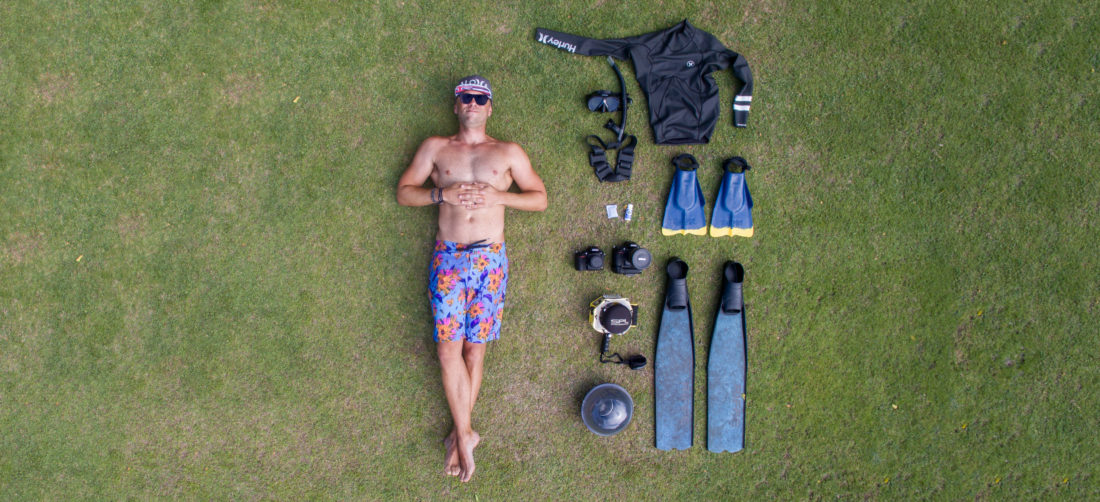
February 21, 2017
In
Behind the Scenes, Gear Review, Personal Work
What’s in my Camera Bag – Underwater Edition
I just got back from a quick trip over to Hawaii to get a little dose of sun and to do some personal shooting. As part of this trip though, I wanted to share some of the gear I use when shooting my underwater work. Unlike my outdoor work, this gear doesn’t all fit into a camera backpack… but instead, in a series of pelican cases and a dive bag. That said, let’s take a look (working from top of photo, down).
- Hurley Fushion 101 Jacket – sure, I might be in Hawaii, but when you go a few feet below the surface, it starts getting cold… and it gets progressively colder the deeper you go. I was slow to start using one of these when I first started diving, but now I swear by them.
- Atomic Subframe Mask – Masks are a personal thing (like ski boots), and I believe in buying the nicest one you can afford when you’re a shooter (if you can’t see, there’s not much reason to be down there). The Atomic is my mask of choice, but choose a mask that fits your face and seals properly.
- Riffe WTB 1000 Weight Belt & Sea Pearls Coated Lead Weights – Whether scuba diving or freediving, weight belts are an important piece of gear, allowing you to dive down and hang out in the depths… instead of rocketing right back to the surface. When shooting underwater, the weight-belt is an even more important piece of gear, in order to offset the buoyancy of your waterproof camera housing. As a freediver, I like the quick release buckle on the Riffe as it allows for a one-pull-release in the event of an emergency. I currently dive with 8 pounds of weight given my size, camera and wetsuit. If you’re curious what you should wear, check out this website. But be cautious when adding weight, as too much is dangerous. Start out light and gradually increase until you find your balance.
- Silica Gel Desiccant – This is the tiny little square next to my elbow. Desiccant is used to suck ambient moisture out of a closed system. It’s the little bag you find in the bottom of a box when you buy a new TV, stereo or any major electronic. For underwater photography, it’s amazing at preventing your camera from fogging inside the housing. While some areas I dive don’t have the humidity to require them, I always dive with a few in my housing just to keep things nice and dry.
- Spit Antifog Gel – My favorite antifog brand for preventing fog on your mask (not for your camera or housing). I prefer the gel.
- DaFin Fins & DaKine Fin Leash – My favorite fins for swimming in surf and strong currents
- Riffe Freedive Fins – I love these fins! If you’ve gone snorkeling and rented your gear, you get a crappy pair of plastic fins. Sure, they’re better than nothing, but they don’t get you anywhere quick. For freediving, having a good pair of fins is a game changer, making each kick or your leg super efficient at propelling you up or down.
- SPL Waterhousings – (A Series) The most important part of my underwater gear quiver (with the exception of possibly the actual camera). I chose to go with SPL when I bought my first housing because of their reputation as being the toughest housings out there. Look at the line-up at Pipeline (or any tough surf break) and look at what water housing you see most… seriously, go google an image. You’ll see the yellow SPL housing more than any other… period. They are bomb proof. Built from a single piece of aluminum (as compared to plastic, fiberglass or carbon fiber) they can take hits off the reef without cracking and flooding. I’m rough on my gear (not intentionally), and I like the idea that my gear is well protected. Additionally, I like the idea of a housing being easy to use. Surf housings are meant to be used in gnarly swell, so buttons are big and easy to use. Dive housings are typically much more precise in my experience and harder to operate when you’re getting tossed around.
SPL advertises that they are only rated to 15-20 feet depth, but I can testify to the fact that they can take much deeper. That said, I am a freediver (not scuba) and I don’t hang out for long periods of time at great depth. But for photography, I don’t like shooting at depth as the light diminishes and color is all but gone the deeper you go. I prefer shooting in the range of 0-30 feet.
I shoot with the Nikon D810 and have ports for the following lenses:- 16mm – fisheye dome port
- 14 – 24mm – over/ under dome port 10 inch
- 28 – 70mm – Full zoom gearing port
That’s pretty much it. Got questions or I missed something? Hit me up in the comments section below.
Cheers!!!




No Comments